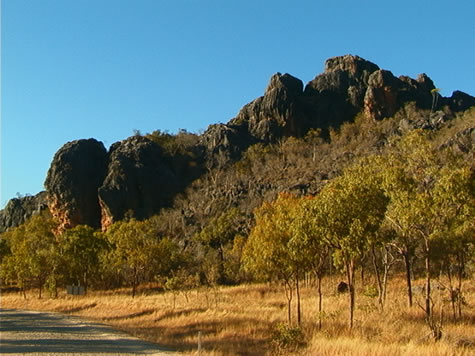2001 August 5, Sunday. Pinnacle Springs Station.
The old rail line snakes through the bush seeking a flat route, dodging between high granite rock piles, which balance incongruously above the landscape, and avoiding the networks of tributaries to the Tate River. Their beds are so dry and sandy it’s hard to believe they were streaming rills just four months ago, and will be later this year, as the wet season approaches again.

Further north the way from which we have come, the granite gives way to limestone and instead of large rounded boulders in piles, jagged limestone monoliths jut from the flat landscape. Peaks as sharp as razors adorn the peaks of outcrops hiding labyrinthine caverns.
The area surrounding Chillagoe is protected by a National Park, which contains hundreds of caves. Limestone is soft, and water penetrates it easily, quickly causing erosion, and leaving the incredible system of tunnels which lie there today.
I took advantage of our rest day in Chillagoe to explore the Royal Arch Caves section of the National Park, using a candle to journey deep into the barren darkness. Nothing can grow inside the caves, because it is so dark. Aboriginal rock art can be found on the peaks above them.
Far down under the earth, moisture seeps from the walls of the caverns, carrying minerals from the sandstone into the air of the cave, where it hardens again. When drips fall from the ceilings of the caves in the same place for a long time, they leave sticks of hardened minerals behind, called stalactites and stalagmites. The two kinds “grow” toward each other from the roof and the floor of the cavern, until they meet and join, and a strong pillar forms which appears to be supporting the cave. These formations can become, over thousands of years, very beautiful and elaborate.
See if you can find out what kind of rock lies under the ground where you live. Have you ever been in a cave? Ask your parents and teacher if they have visited caves. What did they see in there? Bats often live deep inside dark caves, and come out only at night. What else can you think of that might like to live in a cave? Would you like to live inside a cave? Why or why not?
bel